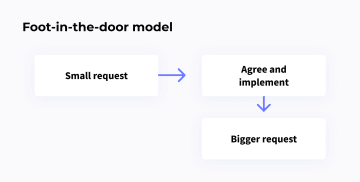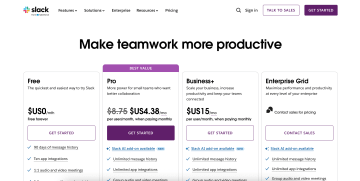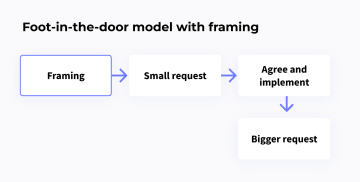Marketing fundamentals
View all articlesWhat is the foot-in-the-door technique? A guide for marketers

Ever agreed to a small favor, only to find yourself signing up for something way bigger five minutes later? That, my friend, is the foot-in-the-door (FITD) technique in action.
This clever persuasion tactic is rooted in social psychology and has been used everywhere — from charitable donations to political campaigns to those sneaky Netflix upgrade prompts. But what makes it so effective for marketers, especially those working in lead generation?
In this guide, we’ll break it all down:
What is the foot-in-the-door technique?
The psychology behind why it works (hello, self-perception theory)
Real-world foot-in-the-door technique examples
How to use it in your marketing funnel to boost conversions
Whether you're running Meta ads, building interactive lead funnels, or experimenting with new compliance techniques, this strategy might just become your next go-to.
What is the foot-in-the-door technique?
The foot-in-the-door (FITD) technique is a social psychology strategy in which people are more likely to agree to a larger request after initially accepting a smaller one.
Someone asks if you have a minute to answer a quick survey. You say sure, why not? A few minutes later, you're signing up for their newsletter and considering a product demo. What just happened?
That’s the foot-in-the-door technique — a classic persuasion strategy rooted in social psychology. The idea is simple: once people say yes to something small, they’re more likely to say yes again to something bigger.

Marketers love this technique because it taps into a powerful human instinct: the need to stay consistent. In their marketing campaigns, this could look like asking a user to fill out a short form, download a free resource, or sign up for a trial — all small, non-intrusive requests.
Once they’ve taken that first step, they’re more open to committing to something bigger, like scheduling a demo, purchasing, or joining a paid plan.
In short:
Start with a modest request, gain compliance, and use that momentum to secure a larger commitment.
Foot in the door technique examples
Whether you’re online shopping, downloading an app, or clicking through a landing page, that “small ask” is often just step one in a well-crafted persuasion strategy.
Here are some examples — some classic, some clever — that show just how powerful this technique can be.
Real Estate: Just tell us what you're looking for
Casavo, a proptech company that simplifies home buying and selling, often starts with a short, non-intrusive form on their homepage or landing pages. Instead of asking users to “Request a property evaluation” right away, they lead with simple questions like:
“Where is your property located?”
“What type of property is it?”
“Is it currently occupied?”
These are quick to answer, feel easy, and help personalize the experience. Once users respond, they’re more invested — and more likely to follow through on the next step, like booking a valuation or speaking with a Casavo advisor.

Charities and good vibes
No one wants to be the person who doesn’t care about cats. That’s why fundraisers often open with: “Do you believe every cat deserves a home?”
After a simple “yes,” it’s much harder to say no when they follow up with: “Will you donate to help feed them?”
This works because you’ve already identified yourself as a good person. Backing out now would feel inconsistent, and FITD loves consistency.
Free car diagnostic: Come for the check, stay for the repairs
Auto shops offering free dash light checkups aren’t just being generous. They’re playing it smart.
You swing by for a non-intrusive request: a free scan. Once you're in the shop and they’ve popped the hood, saying yes to the recommended repairs feels like the obvious next step. You're already there. Your car's already being looked at. The door’s open—literally.
Free trial = gateway to commitment
You’ve seen this everywhere: “Try it free for 14 days.”
Free trials are textbook FITD. You start using the software. You like it. Maybe you even built a workflow or set up integrations. By day 13, you’ve got skin in the game, and that small first step makes it way easier to commit to a paid plan.
Slack, Canva, Notion — take your pick. They’re all walking through your open door.

Product ecosystems: One purchase to rule them all
You buy a phone. Now you need the charger. The case. The watch. The earbuds. The cloud storage. The apps. The fancy pencil that only works with the tablet.
The initial product gets you inside the ecosystem, and everything after that is part of a larger commitment loop. It's the ultimate FITD move disguised as innovation.
Email sign-ups for 10% off
A brand asks for your email in exchange for a small discount. Feels like a win, right?
But now, they’ve got you. That small request gives them permission to drop into your inbox with bigger requests: subscribe to this, try that, check out our newest launch. You’ve signaled interest, and they’re ready to build on it.
Zomato India plays this game brilliantly. They offer users 10% off if they sign up for Zomato Gold, a membership that promises dining discounts and faster delivery. Once you're in, they sweeten the deal again: get 10% off flights through their travel partner Ixigo.

Consulting firms: Small team, big play
Consulting firms often start by embedding a small team into a client’s business — maybe it’s a short-term project or a “free assessment.” Once they’ve proven value, built relationships, and gained trust, it’s easier to pitch larger-scale engagements.
Start small. Earn trust. Expand influence. FITD in a blazer.
The psychology of the foot-in-the-door technique: Why and how it works
At its core, this strategy taps into three powerful psychological forces: framing, self-perception, and consistency.
First: Framing shapes perception
Before the small request even happens, there’s often a framing phase — a subtle way of shaping how the ask is perceived. For example, instead of saying, “Would you like to buy a hard drive?”, you might frame it as, “Would you like to expand your computer’s storage capacity?” That’s less salesy, more helpful, and feels like a no-brainer.
Framing is powerful because it changes the context in which a request is made. Psychologically, it can shift the perceived value, urgency, or effort required, making someone more likely to agree. In FITD terms, framing sits right at the beginning:
Framing → Small Request → Agreement → Bigger Request

Then: Self-perception theory kicks in
Developed by psychologist Daryl Bem, self-perception theory suggests that people look to their own behavior to understand how they feel or what they believe.
So if someone agrees to a small, low-stakes request, like signing up for a free newsletter or answering a brief survey, they subconsciously start to see themselves as someone who supports that brand or cause.
And finally: We strive for consistency
People want to act in line with their past behavior. This is known as the consistency principle, famously explored by psychologist Robert Cialdini. Once someone makes a commitment, however small, they’re far more likely to follow through with future, larger commitments that align with that original behavior.
A classic experiment by Freedman & Fraser (1966) showed this in action. Homeowners who were first asked to display a small “Be a safe driver” sticker were much more likely to later agree to install a giant “Drive Carefully” sign on their lawn, just because they’d already said yes to the smaller ask.
How to use the foot-in-the-door technique in marketing
So, you’ve got their attention, now what? Let’s break down how to use it in real-world marketing campaigns.
Offer a free trial (aka the classic)
Would you ask someone to commit to a 12-month subscription before they’ve even tried the product?
Didn’t think so.
That’s why free trials are a textbook FITD tactic. You’re not just giving people access — you’re inviting them to start building habits. Once a team has set up their workspace, uploaded data, and added their whole team, they’re invested. They’ve made the software part of their day-to-day.
So when the 30 days are up? Saying no doesn’t just feel like stopping a trial. It feels like breaking something they’ve already built.
Tiny ask: Try it free
Bigger ask: Subscribe for the year
The mouse + cookie combo
“If you give a mouse a cookie, he’s going to ask for a glass of milk.”
The same goes for your users.
Let’s say you’re selling an eBook on landing page design. At the end of it, you suggest a landing page audit. From there? A design package. And after that? Maybe a retainer.
This is FITD in sequence. Every small offer sets up the next ask. Each “yes” builds trust and momentum. And since it’s all contextually relevant (cookies need milk!), the upsells don’t feel pushy — they feel helpful.
Use micro-commitments in your funnel
Small steps create commitment. So instead of asking visitors to “Book a demo” right away, warm them up with micro-asks:
Answer a 2-question quiz
Select your industry
Pick your biggest pain point
This creates a sense of progress and reinforces the idea that they’re already involved. And once they’ve interacted a few times, clicking that book a demo CTA isn’t a leap — it’s the next logical step.
Lead magnets with layered value
The FITD technique is embedded in the structure of a great lead magnet. You offer something valuable (like a free SEO checklist) in exchange for an email. That small exchange is the first “yes.”
Then you follow up. Maybe it’s a webinar invite. Then a strategy call. Then a pitch.
If your lead magnet delivers real value, each additional step feels earned. That’s how you go from freebie grab to loyal customer.
Use low-commitment CTAs
Calls-to-action like “Request pricing”, “Get a demo”, or even “Start your free trial” can feel like mini contracts. They signal commitment and pressure — which is exactly what the foot-in-the-door technique tries to avoid.
Instead, frame your CTA as an invitation, not a decision. Phrases like “See how it works”, “Preview in under 30 seconds”, or “Take a quick tour” lower the stakes and make the next step feel easy, exploratory, and safe.
It’s all about framing. Make the first ask sound easy, safe, and maybe even fun. The real power isn’t in the CTA button — it’s in how little pressure it puts on the user.
Turn onboarding into a commitment loop
Ever noticed how some onboarding flows break tasks into tiny steps?
Upload a profile picture
Add your company name
Invite one teammate
Choose a goal
That’s intentional. Each tiny action is a micro-yes. By the end of the flow, the user has already committed multiple times, and walking away would feel like throwing effort in the bin. Even better? It builds a sense of ownership.
Want help making your funnel more FITD-friendly? You know who to call. (Hint: it starts with “Hey” and ends in “flow.”)
Limitations of the foot-in-the-door technique
Like any persuasion strategy, FITD works best in the right context and can backfire if misused.
It only works when the initial request is accepted: If the first “foot” doesn’t land — aka the person rejects your small request — the rest of the funnel collapses. There’s no second ask without the first yes.
Too many small requests can feel manipulative: If the user catches on that you’re stacking asks just to push them toward a big one, they might feel tricked. Trust erodes quickly when things feel too calculated.
The larger request still needs to be realistic: Going from “download a free checklist” to “buy our $10,000 enterprise plan” is a stretch. If the jump feels too big, users will bounce.
Not ideal for urgent conversions: FITD is a long game. It works best in nurture flows and educational funnels, not when you're looking for immediate action.
Doesn’t suit every audience or product: In high-stakes or highly regulated industries (e.g. finance, legal, healthcare), users may be more skeptical and cautious about progressive commitments.
Assumes user attention over time: FITD techniques often depend on a multi-step funnel. If the user drops off after step one, you lose momentum and the opportunity to build toward that bigger ask.
7 Tips for using the foot-in-the-door technique effectively
Here’s how to use the foot-in-the-door technique effectively in your marketing, without overdoing it or losing trust.
Frame the initial ask as a benefit, not a sale: Rephrase your message to highlight value. “Discover how much you could save” lands better than “Request a quote.”
Use personalization to invite first steps: Tailor the small request based on the user’s behavior, interests, or ad source. The more relevant it feels, the more likely they are to comply. With Heyflow’s conditional logic and dynamic paths, you can personalize every step based on user responses, so the experience feels tailored from the very first click.
Appeal to identity and values: People love to feel aligned with who they believe they are. Messages like “Join thousands of smart marketers” or “Support sustainable choices” reinforce that sense of identity.
Demonstrate value before asking for commitment: Offer a preview, a tool, or a helpful resource upfront. If someone gets value from you early on, they’re more likely to take the next step.
Leverage the psychology of consistency: After saying yes once, people feel compelled to stay consistent. Structure your funnel so each ask naturally builds on the last.
Time your bigger ask when engagement is high: Don’t rush. Wait until users have interacted meaningfully — clicked around, completed a step, or spent time on your page — before presenting the next offer.
The foot-in-the-door technique belongs in your funnel
Whether you're optimizing lead gen, boosting sign-ups, or creating more personalized user journeys, FITD gives you a framework that’s rooted in human behavior and proven to work.
And if you're looking for a way to put all of this into action? Heyflow gives you the tools to build interactive forms, landing pages, and lead funnels that actually match how people think and decide. The kind of experience that nudges visitors forward, without making it feel like a sales pitch.
-------------------------------------
Get your foot in the door without kicking it down
Heyflow helps you build interactive funnels so smooth, your leads won’t even realize they’ve been expertly marketed to (in a good way).



